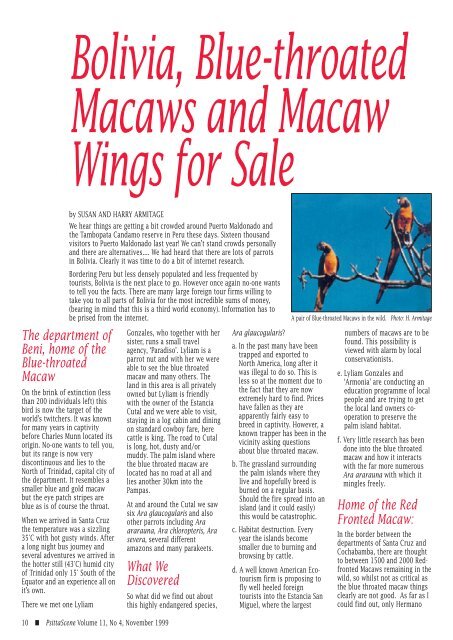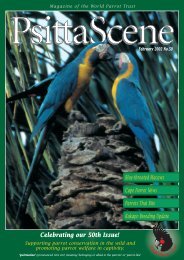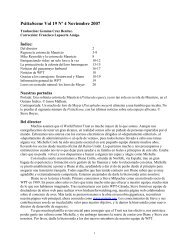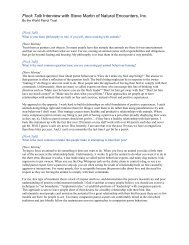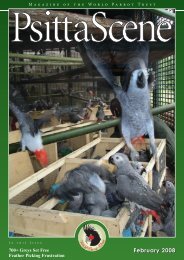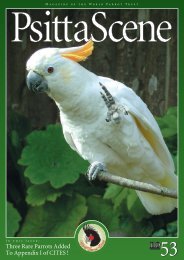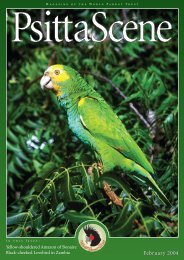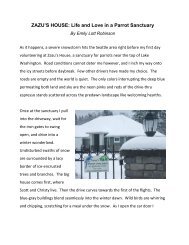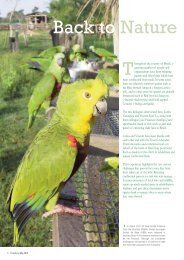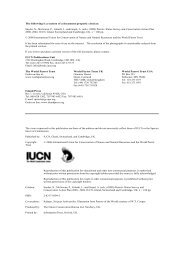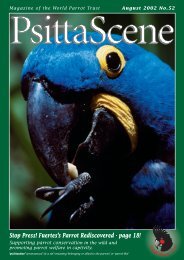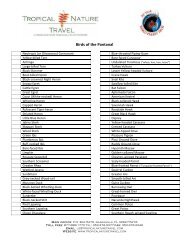Download - World Parrot Trust
Download - World Parrot Trust
Download - World Parrot Trust
Create successful ePaper yourself
Turn your PDF publications into a flip-book with our unique Google optimized e-Paper software.
Bolivia, Blue-throated<br />
Macaws and Macaw<br />
Wings for Sale<br />
The department of<br />
Beni, home of the<br />
Blue-throated<br />
Macaw<br />
by SUSAN AND HARRY ARMITAGE<br />
We hear things are getting a bit crowded around Puerto Maldonado and<br />
the Tambopata Candamo reserve in Peru these days. Sixteen thousand<br />
visitors to Puerto Maldonado last year! We can’t stand crowds personally<br />
and there are alternatives.... We had heard that there are lots of parrots<br />
in Bolivia. Clearly it was time to do a bit of internet research.<br />
Bordering Peru but less densely populated and less frequented by<br />
tourists, Bolivia is the next place to go. However once again no-one wants<br />
to tell you the facts. There are many large foreign tour firms willing to<br />
take you to all parts of Bolivia for the most incredible sums of money,<br />
(bearing in mind that this is a third world economy). Information has to<br />
be prised from the internet.<br />
On the brink of extinction (less<br />
than 200 individuals left) this<br />
bird is now the target of the<br />
world’s twitchers. It was known<br />
for many years in captivity<br />
before Charles Munn located its<br />
origin. No-one wants to tell you,<br />
but its range is now very<br />
discontinuous and lies to the<br />
North of Trinidad, capital city of<br />
the department. It resembles a<br />
smaller blue and gold macaw<br />
but the eye patch stripes are<br />
blue as is of course the throat.<br />
When we arrived in Santa Cruz<br />
the temperature was a sizzling<br />
35°C with hot gusty winds. After<br />
a long night bus journey and<br />
several adventures we arrived in<br />
the hotter still (43°C) humid city<br />
of Trinidad only 15° South of the<br />
Equator and an experience all on<br />
it’s own.<br />
There we met one Lyliam<br />
10 ■ PsittaScene Volume 11, No 4, November 1999<br />
Gonzales, who together with her<br />
sister, runs a small travel<br />
agency, ‘Paradiso’. Lyliam is a<br />
parrot nut and with her we were<br />
able to see the blue throated<br />
macaw and many others. The<br />
land in this area is all privately<br />
owned but Lyliam is friendly<br />
with the owner of the Estancia<br />
Cutal and we were able to visit,<br />
staying in a log cabin and dining<br />
on standard cowboy fare, here<br />
cattle is king. The road to Cutal<br />
is long, hot, dusty and/or<br />
muddy. The palm island where<br />
the blue throated macaw are<br />
located has no road at all and<br />
lies another 30km into the<br />
Pampas.<br />
At and around the Cutal we saw<br />
six Ara glaucogularis and also<br />
other parrots including Ara<br />
ararauna, Ara chloropteris, Ara<br />
severa, several different<br />
amazons and many parakeets.<br />
What We<br />
Discovered<br />
So what did we find out about<br />
this highly endangered species,<br />
Ara glaucogularis?<br />
a. In the past many have been<br />
trapped and exported to<br />
North America, long after it<br />
was illegal to do so. This is<br />
less so at the moment due to<br />
the fact that they are now<br />
extremely hard to find. Prices<br />
have fallen as they are<br />
apparently fairly easy to<br />
breed in captivity. However, a<br />
known trapper has been in the<br />
vicinity asking questions<br />
about blue throated macaw.<br />
b. The grassland surrounding<br />
the palm islands where they<br />
live and hopefully breed is<br />
burned on a regular basis.<br />
Should the fire spread into an<br />
island (and it could easily)<br />
this would be catastrophic.<br />
c. Habitat destruction. Every<br />
year the islands become<br />
smaller due to burning and<br />
browsing by cattle.<br />
d. A well known American Ecotourism<br />
firm is proposing to<br />
fly well heeled foreign<br />
tourists into the Estancia San<br />
Miguel, where the largest<br />
A pair of Blue-throated Macaws in the wild. Photo: H. Armitage<br />
numbers of macaws are to be<br />
found. This possibility is<br />
viewed with alarm by local<br />
conservationists.<br />
e. Lyliam Gonzales and<br />
‘Armonia’ are conducting an<br />
education programme of local<br />
people and are trying to get<br />
the local land owners cooperation<br />
to preserve the<br />
palm island habitat.<br />
f. Very little research has been<br />
done into the blue throated<br />
macaw and how it interacts<br />
with the far more numerous<br />
Ara ararauna with which it<br />
mingles freely.<br />
Home of the Red<br />
Fronted Macaw:<br />
In the border between the<br />
departments of Santa Cruz and<br />
Cochabamba, there are thought<br />
to between 1500 and 2000 Redfronted<br />
Macaws remaining in the<br />
wild, so whilst not as critical as<br />
the blue throated macaw things<br />
clearly are not good. As far as I<br />
could find out, only Hermano


